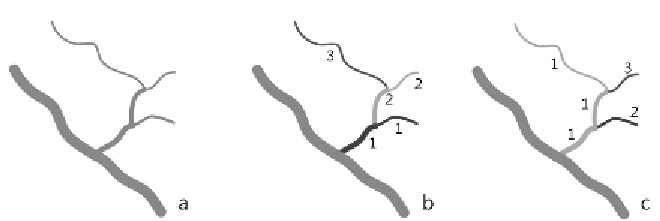Geoscience Reference
In-Depth Information
•
it belongs to the highest IGMI hydrography class,
•
it has the highest value
L,
•
it has the highest value
B,
•
it has the largest width.
The score will be decreased if the father edge:
•
it has a different name from the current edge,
•
it has a lower Strahler order than the current edge.
The idea behind this scoring is to try to find, at each fork, the most relevant
branch of the river. The scoring mechanism of course is not perfect but our
aim is not to reconstruct perfectly the course of a river, but to have a good
approximation of it.
If the current edge has not any father edge, the course of this river has been
reconstructed to its source: all the edges touched have been flagged and
added with a unique id; the procedure is then repeated, starting from the
edge with the highest Strahler order among those not yet flagged.
Figure 6:
reconstructing the river courses; a) source data, b) a possible reconstruction, c)
the one chosen by the algorithm (numbers indicate to which course each section belongs
to); the reconstruction tries to create long courses; in c the small courses 2 and 3 are likely
to be deleted because they are too short; in b if the course 1 was deleted because too
short, also 2 and 3 would be deleted thus pruning the network too much.
2.3.4 Short rivers pruning
Once that the course of each river has been reconstructed it is straight for-
ward to apply the IGMI minimum length threshold: the length of every
river course is calculated as the sum of all its sections and if the length is
smaller than the threshold all the sections belonging to it are deleted.

